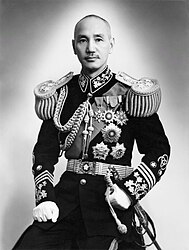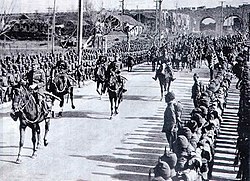The Chinese Civil War was a very long-running conflict which was fought in China between 1927 and 1949. The war was fought primarily between the Chinese nationalists, known as the Kuomintang, and the Chinese communists, though other regional groups were involved at times. The war also had different stages to it and was interrupted by the Japanese invasion of China in 1937, an emergency which saw a loose ceasefire within the civil war until the Japanese were largely expelled from China in 1945. Thereafter it resumed and was fought bitterly for another half a decade. It only ended in 1949 when the communists under their new leader Mao Zedong emerged victorious. However, the Kuomintang were not utterly defeated and they left mainland China to occupy Taiwan, creating the modern-day division between China and Taiwan. The civil war led to mass displacement and demographic change across China, not least in the flight of over a million people to Taiwan in the late 1940s and the early 1950s.[1]
Chinese Civil War chronology of events

The second half of the nineteenth century and the start of the twentieth was an era of immense change for China and also one of great political and social pain. The country was repeatedly humiliated in war against foreign powers like Britain and France from the late 1830s onwards, notably during the Opium Wars. Then the arrival of new political and social ideas into China led to a breakdown of traditional society, social unrest and frequent rebellions, notably the Boxer Rebellion at the end of the 1890s. To compound matters, Japan managed its modernization much more effectively and between the 1870s and 1890s replaced China as the pre-eminent power over the Kingdom of Korea. Finally, in 1911 the imperial system of governance and rule which had held firm in China for thousands of years collapsed and in its place the first Republic of China emerged. Yet it was always unstable and in 1926 Chiang Kai-Shek and his nationalist movement, the Kuomintang, launched the Northern Expedition and claimed power over much of the country by 1927. This led to the outbreak a civil war between the nationalists and the Chinese communist movement, the latter of which enjoyed growing support from the Soviet Union.[2]
The civil war went through a number of different stages. In its early years it might well have ended in victory for the Kuomintang as the communists were largely hemmed into a small piece of territory in central China and faced near defeat between the end of the 1920s and the mid-1930s before the Long March broke through the nationalist lines and kept the communist movement barely alive.[3] What saved them and prevented the Kuomintang from seizing power fully across the region was Japanese intervention in the country. They conquered Manchuria and set up the puppet state of Manchukuo in 1931 and then in 1937 began a wider invasion of eastern China, occupying the major cities here such as Beijing and Nanjing. As a result, a precarious truce developed between the nationalists and the communists as they fought a growing patriotic struggle against the Japanese. They were aided by massive material and technological assistance from the Allies as the Second World War began from 1939 onwards. It was also during the war against Japan that Mao Zedong emerged as the undisputed leader of the Chinese communists.[4]

With the expulsion of the Japanese from China in the course of 1945 and the end of the wider Second World War the following year, the Chinese Civil War recommenced. Millions of troops were involved and there was widespread displacement of civilians across China.[5] It eventually ended in 1949 as the nationalists, who were receiving less assistance from the United States and other western nations than the communists were receiving from the Soviet Union, realized that they were defeated and began preparing to retreat to the island of Taiwan. Here they continued to claim that they were the government of the Republic of China, though the country is typically referred to simply as Taiwan today. The communists decided against invading Taiwan after consolidating their control over the China as the United States indicated its willingness to intervene to protect the independence of the Republic on Taiwan in the 1950s. There remains a constant threat of a regional war developing if the communist regime in China tries to seize Taiwan.[6]
Extent of migration during and after the Chinese Civil War
The Chinese Civil War led to enormous levels of migration. Some studies suggest that the combined effects of the civil war from 1927 onwards and the Japanese invasion in 1937 led to as many as 100 million people being displaced by the mid-1940s. Many of these were not able to return to their places of origin even in 1945 as the civil war resumed and fighting continued. This was an immense level of migration, though much of it was temporary. A more concrete and lasting form of migration came in the late 1940s as over a million people fled from the Chinese mainland to Taiwan.[7]
Demographic impact of the Chinese Civil War
The demographic impact of the displacement and movement of tens of millions of people is hard to understate. But the lasting impact of it in terms of creating major social change in China was very great. It also led to spill-over migration. For instance, many people tried to gain entry to the foreign enclaves in southern China in the 1930s, Portuguese-ruled Macau and British-ruled Hong Kong. Hong Kong’s population doubled from 800,000 to 1.6 million people between 1937 and 1941, while Macau’s grew from around 140,000 to 500,000 between 1937 and the end of the Second World War.[8]
However, perhaps the most tangible shift in terms of modern politics and society in the Far East was the exodus to Taiwan. This was a region of limited population growth for much of the first half of the twentieth century. There were just over three million people living on the island in 1900, growing gradually to 3.7 million by 1920. As Taiwan became a haven from the violence and unrest of the mainland the population grew much faster from the late 1920s onwards. It had expanded to six million in 1940 and then grew to 10.7 million people in 1960 after the mass migration at the end of the civil war. Natural increase augmented this inward migration from mainland China thereafter and by the end of the twentieth century there were over 22 million people living on Taiwan, seven times what the population had been in 1900. This was a major demographic impact of the Chinese Civil War.[9]
Explore more about the Chinese Civil War
- Chinese Genealogy: An Introduction to Jiapu 家譜 (Chinese Genealogy Records) at Legacy Family Tree Webinars
- Chinese American Research: Challenges and Discoveries at Legacy Family Tree Webinars
- The Chinese Civil War at HistoryExtra
References
- ↑ https://www.historyextra.com/period/20th-century/chinese-civil-war-china-chiang-kai-shek-mao-zedong-communism/
- ↑ https://www.history.com/topics/asian-history/china-timeline
- ↑ https://www.oxfordreference.com/display/10.1093/oi/authority.20110803100114870
- ↑ https://www.britannica.com/event/Second-Sino-Japanese-War
- ↑ https://digitalarchive.wilsoncenter.org/topics/chinese-civil-war-1946-1950
- ↑ https://history.state.gov/milestones/1953-1960/taiwan-strait-crises
- ↑ Rana Mitter, ‘Relocation and Dislocation: Civilian, Refugee, and Military Movement as Factors in the Disintegration of Postwar China, 1945–49’, in Itinerario, Vol. 46, No. 2 (2022), pp. 193–213.
- ↑ http://refugeehistory.org/blog/2022/12/1/refugees-and-neutral-territories-hong-kong-and-macau-during-world-war-ii
- ↑ Irene B. Taeuber, ‘Population Growth in a Chinese Microcosm: Taiwan’, in Population Index, Vol. 27, No. 2 (April, 1961), pp. 101–126.